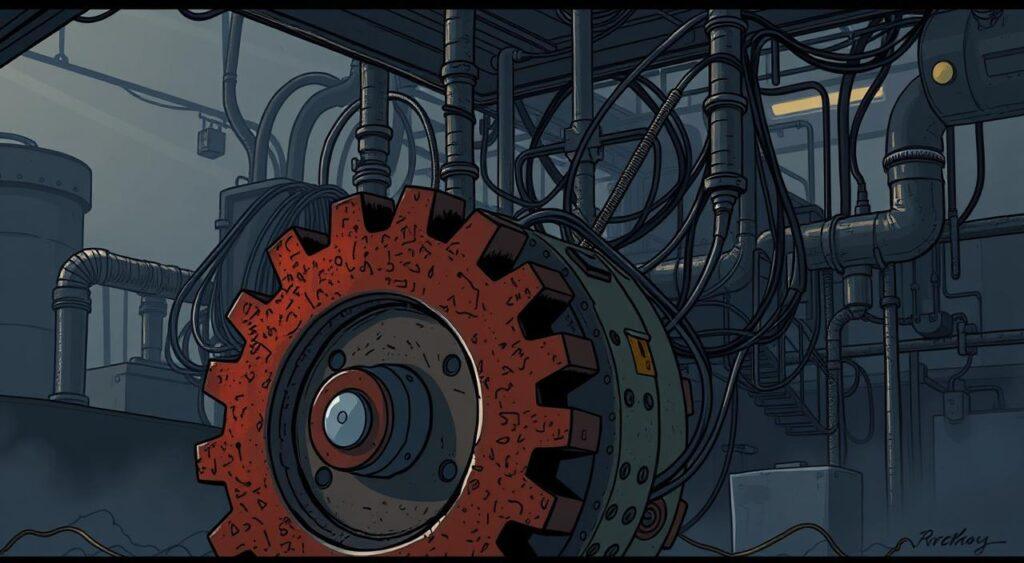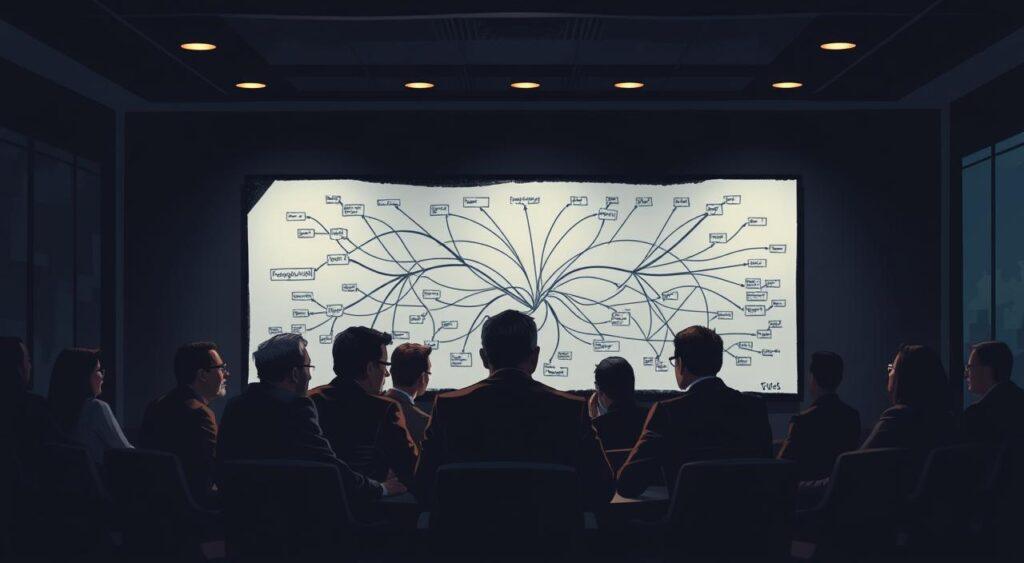The path dependence mental model shows how early choices can set us on a path. These choices, no matter how small, can make it hard to change later. This is because of sunk costs, habits, or big investments.
Examples include QWERTY keyboards, old software, or career choices. History plays a big role in what we think is possible.
This model helps us see why changing things can be tough. It’s key in economics, tech, and how organizations work. Knowing when old decisions are holding us back can help us move forward.
In this article, you’ll learn about the history and science behind path dependence. You’ll see examples and how it affects us. You’ll also get tips on spotting when it’s time to make a change.
Key Takeaways
- Path dependence mental model: Early decisions often set invisible boundaries for future choices
- Sunk costs (time, money, effort) keep people on outdated paths
- This framework applies to personal habits and global industries alike
- Different starting points can lead to wildly different outcomes
- Focusing on future potential helps break free from limiting patterns
By the end of this guide, you’ll see how the path dependence mental model shapes everything from morning routines to tech standards—and how to build more adaptable strategies.
Introduction to the Concept of Path Dependence
Think of a river carving its way through stone. What begins as a trickle gains momentum, etching deeper channels over time. Soon, even heavy rains follow these grooves—not because they’re the best route, but because they’re already established. This mirrors how the path dependence mental model operates in real life.
Our world runs on patterns set by earlier choices. Companies adopt outdated software simply because “that’s how we’ve always done it.” People keep unhealthy routines long after better options emerge. These aren’t flaws in logic—they’re proof that history actively shapes what’s possible today.
Unlike basic cause-and-effect reasoning, this concept reveals hidden forces at play. Early tech standards, for instance, often win not through superiority but timing. Once adopted, they become the foundation for future tools—even when limitations appear.
Three critical insights emerge:
- Small decisions often build invisible guardrails around future options
- Systems develop self-reinforcing habits that resist change
- Breaking free requires recognizing these ingrained patterns
By studying such dynamics, we gain tools to question default paths. Whether choosing career moves or designing business strategies, understanding these principles helps identify when to pivot—and when to forge new trails entirely.
Historical Roots and Evolution of Path Dependence

Imagine planting a tree whose branches dictate where new growth can emerge. That’s how ideas about historical influences on systems first took shape in the context of path dependence analysis.
Scholars noticed patterns where early choices in the development of a path became embedded in structures—like railroad tracks determining trade routes for centuries.
Early Economic Thought and Institutional Origins
In the 1930s, thinkers like Thorstein Veblen questioned why markets didn’t always self-correct. They observed industries clinging to outdated practices despite better alternatives. This laid groundwork for understanding how initial conditions create lasting trajectories.
By the 1980s, economists formalized these observations. Traditional models struggled to explain why inferior technologies dominated markets. Studies of economic development patterns revealed how early industrial standards became locked in—even when newer options offered clear advantages.
Influence of Historical Events on Modern Systems
Consider railroad gauges. The width of ancient Roman chariots influenced 19th-century train tracks—which still shape modern transit. Such examples show how historical events create ripple effects across generations.
World War II accelerated this understanding. Postwar reconstruction revealed how crisis decisions—like choosing factory locations—could define regional economies for decades. These insights helped scholars see the invisible hand of history in today’s systems.
Why does this matter? Recognizing these roots helps us separate past constraints from present possibilities. What routines or systems in your life might reflect yesterday’s solutions—not tomorrow’s potential?
Theoretical Foundations of Path Dependence
Picture a snowball rolling downhill. What starts as a small cluster grows heavier, carving grooves in the mountainside. Future snowfall follows these tracks—not because they’re ideal, but because momentum makes deviation costly. This mirrors how systems develop self-reinforcing patterns over time.
| Principle | Definition | Real-World Example |
|---|---|---|
| Increasing Returns | Early advantages grow exponentially as adoption increases | VHS tapes outperforming Betamax despite lower quality |
| Critical Junctures | Brief windows where small choices create lasting impacts | 19th-century railroad gauge decisions |
| Lock-In Effects | Systems become resistant to change despite better options | QWERTY keyboard layouts in digital age |
These foundations reveal why some choices echo through decades. When companies stick with outdated software or individuals repeat unhelpful routines, it’s often these invisible forces at work—not stubbornness.
The power lies in recognition. By understanding these mechanisms, we gain tools for smarter analysis. Tech innovators use this framework to anticipate adoption trends. Personal coaches apply it to break habit cycles. What routines in your life might follow yesterday’s grooves instead of tomorrow’s potential?
This is a good place to apply the inertia mental model as well. The path dependence mental model shows how past choices keep us stuck. Inertia, on the other hand, shows our inner fight against change, even when it makes sense.
Together, they tell us why systems stick to what they know, even when something better comes along.
Understanding the Concept of Sunk Costs and Habits
Imagine standing at a bridge you’ve spent years building. Walking away feels unthinkable—even if a safer crossing exists downstream. This captures how sunk costs and ingrained habits trap us in outdated patterns. Once we invest time or identity into a choice, switching lanes feels like admitting defeat.
Businesses face this daily. A company might keep using clunky software because employees know it—despite better tools existing. Training costs and fear of disruption outweigh potential gains. Similarly, individuals stick with unsatisfying careers or routines, thinking “I’ve come this far.”
Habits act like personal railroads. Each repetition deepens the tracks. Morning coffee runs become automatic—even when caffeine jitters hit. As neuroscientist Ann Graybiel notes, neural pathways strengthen with repetition, making old patterns feel “right” even when ineffective.
Three warning signs you’re stuck:
- Defending choices based on past effort, not current value
- Feeling physical resistance when considering change
- Repeating actions while expecting different results
Breaking free starts with a simple question: “If starting fresh today, would I choose this?” Therapists use this in addressing the sunk cost fallacy within personal relationships. The same logic applies to business strategies or daily routines.
What bridge have you been maintaining that no longer serves your journey forward?
Path Dependence in Technology and Organizational Systems

Cities don’t choose their street grids twice. Once laid, roads shape where buildings rise, traffic flows, and communities grow—even when better layouts emerge. This mirrors how technology standards and organizational processes become locked into patterns set by early decisions.
Consider smartphone operating systems. iOS and Android gained early adoption through app ecosystems and developer tools. Today, switching costs—like retraining staff or rebuilding software—keep these systems dominant despite potential alternatives. Network effects amplify this: more users attract more apps, which attract more users.
Companies face similar traps. Outdated accounting software lingers because employees know its quirks. Training new hires on unfamiliar tools seems costlier than tolerating inefficiencies. As strategic decision-making research shows, cultural acceptance often overrides logic.
Three forces deepen these grooves:
- Complementary investments (custom plugins, specialized skills)
- Fear of disrupting workflows
- Perceived risks of untested solutions
Breaking free requires asking: “Does this system still serve us, or are we serving it?” Like city planners widening bike lanes in car-centric grids, organizations must balance legacy investments with future needs. What outdated tracks guide your daily operations?
Economic Perspectives: Increasing Returns and Feedback Mechanisms
Imagine a baker perfecting a recipe. Each tweak builds expertise—sooner or later, their bread gains fame. Customers flock in, suppliers offer better deals, and competitors struggle to match their quality. This snowball effect captures increasing returns in action—where early wins create bigger advantages over time.
Economist W. Brian Arthur reshaped how we view growth. Traditional models assumed profits diminish as markets saturate. But he showed tech and knowledge sectors flip this rule. Early adopters of innovations—like cloud computing tools—gain compounding benefits. Skills deepen. Networks expand. Costs drop as systems scale.
Digital platforms exemplify this best. Social media giants thrive on feedback loops: more users attract more content creators, which pulls in more users. Once ahead, they become nearly unstoppable. Traditional industries like manufacturing can’t replicate these dynamics—their growth curves flatten over time.
Three forces drive this phenomenon:
- Learning curves that turn early experiments into unbeatable expertise
- Network effects where value grows exponentially with each new participant
- Infrastructure investments that lower costs for incumbents while raising barriers for newcomers
These mechanisms explain why startups race to dominate niches quickly. They’re not just selling products—they’re building ecosystems. Miss the initial window, and catching up becomes prohibitively expensive.
Arthur’s work answers puzzles older models couldn’t. Why do inferior technologies sometimes dominate? How do regional tech hubs outpace entire nations? The answers lie in recognizing how small head starts can lock in lasting advantages.
Where have you invested in systems that reward early momentum?
Critical Junctures and Contingency in Decision-Making

Watch two raindrops hit a mountain ridge. One flows east, the other west—their paths determined by microscopic cracks in the rock. Life’s turning points work similarly within complex systems.
Brief moments where choices ripple into decades of consequences, influencing processes and resulting in significant shifts in information and institutions.
Evaluating the Impact of Early Choices
Startups face this during funding rounds. A “no” from one investor might push founders toward less ideal partners—shaping company culture for years. These critical junctures aren’t always obvious. They hide in job offers, project timelines, or casual conversations.
Three factors magnify their importance:
| When It Matters | Example Scenario | Key Strategy |
|---|---|---|
| Timing before systems solidify | Choosing first hires in a new team | Prioritize adaptability over narrow skills |
| Unpredictable external shifts | Market crashes altering career paths | Build optionality into plans |
| Self-reinforcing outcomes | Early customers defining product roadmaps | Separate signal from noise in feedback |
Contingency plays a stealth role here. A delayed train causing a missed meeting might spark a pivotal partnership. Research on historical economic shifts shows how random events redirect entire industries.
To navigate these moments:
- Map decision trees during calm periods
- Identify inflection points in your goals
- Leave room for course corrections
Ask yourself: Which of today’s choices might future me view as life-altering?
Self-Reinforcement and Positive Feedback Loops
Picture a community garden where early plantings shape future growth. Tomatoes thrive in sunny plots, so gardeners add compost there. Soon, other plants struggle to compete—the tomatoes’ success fuels more investment in their corner.
This cycle mirrors how self-reinforcing systems operate. Small advantages multiply, creating feedback loops that solidify outcomes.
Mechanisms Behind Feedback Systems
Three key mechanisms drive these cycles:
| Driver | How It Works | Example |
|---|---|---|
| Network Effects | Value grows as more users join | Social media platforms gaining dominance |
| Skill Stacking | Early practice accelerates later learning | Musicians mastering complex pieces faster |
| Resource Allocation | Success attracts more funding/tools | Startups securing follow-on investments |
Path Dependence Mental Model: Increasing Returns Explained
Unlike traditional economics where efforts yield diminishing results, increasing returns create exponential gains. A baker’s tenth loaf requires less flour waste than the first.
Tech companies improve products faster as user data flows in. These compounding benefits explain why early leaders often stay ahead.
Consider app stores. Developers flock to platforms with the most users. More apps attract more customers. This loop makes challenger stores nearly impossible to launch—even with better features. Once established, the cycle sustains itself.
Where have you seen small starts create unstoppable momentum in your work or hobbies?
Inertia and Lock-In: Consequences of Path Dependence

Consider a train switching tracks. Once moving at full speed, changing direction demands immense force—even if the current route leads nowhere. Systems work similarly. Early investments in tools, training, or traditions create inertia that resists change.
Organizations keep outdated payroll systems. Cities maintain inefficient transit networks. Why? Because stopping momentum feels riskier than continuing.
| Challenge | Root Cause | Solution |
|---|---|---|
| Employee resistance to new software | Years spent mastering legacy systems | Phase-in training with quick-win features |
| Industry-wide tech standards | Network effects from early adoption | Create open-source alternatives |
| Personal habit cycles | Neural pathways strengthened by repetition | Micro-changes disrupting automatic behaviors |
Lock-in occurs when switching costs outweigh benefits. A company might spend $500k annually on an old CRM—but fear $200k migration fees more. Sound illogical? It’s human nature. We overvalue known pains versus unknown gains.
This idea matches the sunk cost fallacy mental model. It explains why we often stick with something because we’ve already invested in it. Knowing both helps us make better choices by overcoming our own biases and the systems that hold us back.
Breaking free starts with honest audits. Ask: “Does this still serve us?” Track metrics before/after proposed changes. Pilot small-scale tests to prove value. Like loosening rusted bolts, gradual pressure works better than sudden force.
What tracks have you been riding because stopping seems too hard?
Real-World Examples: The QWERTY Keyboard and Legacy Systems

Press your fingers on any computer keyboard. There’s a 96% chance they’re resting on QWERTY keys—a layout designed for 19th-century typewriters. Yet this design still dominates digital devices, not because it’s best, but because we’re all trained to use it.
Stanford researcher Paul David shattered myths about this system. Contrary to popular belief, QWERTY wasn’t created to slow typists. Early typing schools adopted it, creating a workforce skilled in this layout. Manufacturers followed, locking the standard into global production lines.
Modern organizations face similar traps. 62% of IT leaders report legacy software blocking innovation. Like QWERTY, these systems persist due to:
- Employee retraining costs
- Integration with existing tools
- Fear of operational downtime
Network effects amplify the challenge. Each new QWERTY typist made alternative layouts less viable. Today, cloud platforms and CRM tools create comparable inertia—switching risks disrupting entire workflows.
The Role of Network Effects in Locking Standards
Network effects are key in keeping systems stuck in their ways. When a product or platform starts to gain popularity, it becomes more valuable. This draws in even more users, creating a cycle that’s hard to break.
QWERTY is a great example. It didn’t stay popular because it was the best. Instead, it was because everyone was already using it. This created a big, shared system that was hard to change.
Today, we see the same thing with tech platforms. Companies find it hard to switch from Salesforce or Microsoft. It’s because of how well these systems work together and how familiar everyone is with them. Changing to something new is a big challenge.
Knowing about network effects helps us understand why we often stick with old systems. These forces don’t just keep things the way they are. They make changing to something new very difficult. It’s important to recognize these patterns to move forward and innovate.
Understanding the Path Dependence Mental Model
Consider a novel where early chapters shape the entire plot—choices made in Act One ripple through every subsequent page. This mirrors how path dependence operates as a decision-making lens. By viewing choices through this framework, you gain tools to spot when history—not logic—guides your actions.
Key markers reveal entrenched patterns. Look for systems where:
- Past investments justify continued use despite better options
- Habits feel automatic even when counterproductive
- Change triggers disproportionate resistance
Ask two critical questions: “Would I start this today?” and “What future doors does this keep open?” Tech giants use this approach to avoid legacy system traps. Individuals apply it to break cycles like staying in unfulfilling jobs.
The real power lies in anticipation. Systems with strong network effects—social platforms, industry standards—rarely get displaced. But niches with high friction? These invite disruption. Train yourself to distinguish between sunk costs and future potential.
Conclusion
The path dependence mental model shows how past choices affect us today. It’s about how old decisions, like outdated tech or career paths, limit us. But, we can break free by spotting sunk costs, finding key moments, and fighting automatic habits.
When you’re looking to improve, ask yourself: “Would I pick this path now?” If not, it’s time to change direction.
Want to know how this model ties into status quo bias or inertia? Explore more mental models in our library. They help you make informed choices and stay adaptable.


